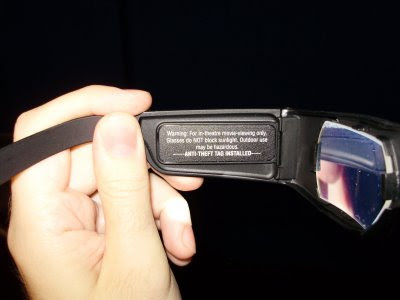The system provides realistic color reproduction and extremely sharp images.

INFITEC 3D is similar to polarised 3D with a few distinct advantages. Firstly, and most importantly, you don't need a silver non-depolarising screen, you can project 3D onto a standard white screen or even straight onto a wall if you want. Infitec is also not affected by viewing angles, so you don't lose 3D if you tilt your head!
According to the press releases the reusable glasses significantly reducing the cost per viewing and are environmentally friendly. The nature of the filters for each eye are much more expensive then plastic polarizers, but deliver a much better result.
They were using a glass or very hard plastic filters that were very high quality but it's not cheap. One theater operator I talk with said he was paying $38 per pair.

The glasses include an anti-theft RF tag.

Dolby 3D Digital Cinema technology, in conjunction with digital cinema projectors featuring Texas Instruments Digital Light ProcessingTM (DLP) technology, provides exhibitors with an efficient and flexible solution designed to deliver a superior 3D experience. Dolby 3D utilizes standard white screens, so exhibitors don't have the added cost or the quality compromise associated with the use of silver screens, delivering a consummate 3D experience from every seat in the house.
Infitec's 3-D technology was originally a research project of Daimler Chrysler for automotive design uses. Under the project title "wavelength multiplex visualization system" it was investigate the new approach to improving image quality and to enlarge functionally in Virtual Reality systems.
In July 2006 Infitec teamed up with Dolby Digital to produce 3-D cinemas. Jan 09 Infitec founded a new company for it's new technology Infitec Dualcolor3D.
Infitec uses a technique for channel separation in stereo projections based on interference of filter (In terferenz fi lter tec hnologie).
JDSU is the world's largest producer of optical coatings, developed the 3D filter wheel technology that is used and makes the lenses for the glasses.
Here the pictures for the left and right eye are projected with basic colors of different wavelength (wavelength multiplexing)

- Left eye: Red 629nm, Green 532nm, Blue 446nm
- Right eye: Red 615nm, Green 518nm, Blue 432nm
The channel separation of the projected images is done with a pair of of glasses that have selective interference filters for each eye.
Each lens filters the suitable wavelength triple with selective interference filters for each eye.
This has some advantages over the other 2 technologies that for 3D, polarization and Shutter goggles.
It has the advantage of the shutter goggle in that it can use a standard white screen rather than a costly silver screen. A white screen cost ~$6000 while a same size silver screen can cost ~$16000.
It also has the advantages over the shutter goggle similar to the polarization systems (RealD and MasterImage) in that it's passive so there is not thing to fail. No batteries, connections or active electronics.
I suspect it's lower cost the the shutter goggles too.
More info:
Dolby Digital 3D vs Real D / Master image systems.
Dolby® 3D Digital Cinema
Infitec - Infitec Dualcolor3D
Disney Digital 3-D™
NAB 3D
Wavelength Multiplexing
JDSU and Dolby Deliver Premium 3D Movie Experience on the Dolby web Site
JDSU and Dolby Deliver Premium 3D Movie Experience On the JDSU web site.
Dolby 3D Glasses Training Video This is a fun video



5 comments:
Thanks for posting, especially the light intensity chart for the filters. That explains it! I've seen notch filters for work in labs with lasers, but never for a consumer product.
I am very curious what the outside world looks like with these notch-filter glasses. What does nature look like with these goggles on? Do flowers look different? In theory, you should be able to see things that you can't see with your normal eyes! I bet that fluorescent lights or LEDs or lasers look very strange (different in one eye than the other). Anything with a narrow spectral emission should be cool looking. Let me know if you get a chance!
Bob you can see LED's in the Theater only show in one eye or appear to be different colors in each eye. I've never taken out outdoors. They stopped using them here, but when they did they had RFID security tags so you couldn't steal them.
Hi John,
I’m Cuti from Rio de Janeiro - Brazil.
I have a question, and maybe you can help me.
I'm a motion designer, and I produced a intro with 10" for Movie Theater in Adobe After Effect. But I did it in 2d.
Do you know how can I convert or render this project to exhibition in a movie theater?
My client have a Dolby system DSS200 Polarized – passive in your movie theater, and 2 projectors Barco DP2K-23B and Christie CP2220.
I just need to know how I render this Project, if is 2 cameras (left and right eyes), different colors or some exclusive codec.
Can you help me?
I can’t find any explain or tutorial in internet.
Thanks so much!
Cuti DJ,
You would have to see the Dolby system DSS200 manual which I couldn't find online, or go through the local Dolby distributor thought the Theaters customer account with them. This should get you access to a customer web portal and support documents as well.
I expect it would accept a Side by Side 3D formats in jpeg2000, mpeg2 or mpeg4.
I recommend using Sony Vegas Pro. It's the only one I've tried for 3D content but it works well.
Alternately you could bypass the DSS200 and drive the two projectors with polarizers from a Windows PC with a high end graphics card and dual DVI outputs.
John
Post a Comment